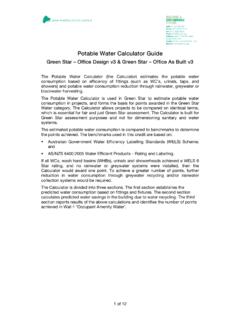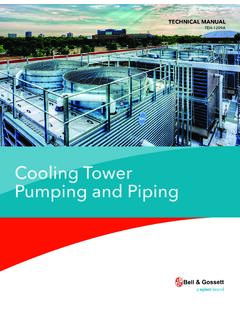Transcription of Sizing & Selecting - Delta Cooling
1 Sizing & Selecting How comfortable are you working up a Cooling tower selection? The Cooling tower selection table can look confusing, but after you have made a few selections the process is straightforward. If you need a refresher, this may help. The following design data is required to select Cooling towers : Flow Rate in GPM Range of Cooling in F (T1 - T2) Area Wet Bulb Temperature in F (Twb) The Design Heat Load is determined by the Flow Rate, and the Range of Cooling , and is calculated using the following formula: Heat Load (BTU/Hr) = GPM X 500 X Range of Cooling More importantly, if the Heat Load, and one of the other two factors are know, either the GPM or the Range of Cooling , the other can be calculated using this formula. For example: GPM = Heat Load (BTU/Hr) , or 500 X Range of Cooling Range of Cooling = Heat Load (BTU/Hr) 500 X GPM So, as you can see, the Design GPM and the Range of Cooling , are directly proportional to the Heat Load.
2 500 is the fluid factor this is based on water as the heat transfer fluid. The fluid factor is obtained by using the weight of a gallon of water ( lbs.) multiplied by the specific heat of the water ( ) multiplied by 60 (minutes). The first step in Selecting a Cooling tower is to determine the Nominal Cooling tower load. Since a Cooling tower ton is based on 15,000 BTU/Hr, the formula is: Nominal Load = GPM X 500 (Constant) X Range of Cooling , 15,000 BTU/Hr/Ton or, the more simplified version of the same formula, Nominal Load = GPM X Range of Cooling 30 Sizing & Selecting Once the Nominal Cooling load has been calculated, a Correction Factor must be determined to calculate the Actual Rated Cooling tower tons required for the specific conditions of service.
3 The correction factor adjusts for the ease or difficulty of Cooling based on the Theoretical Design of all Cooling towers . The Nominal Ton Correction Factor is determined by using the COUNTERFLOW Cooling TOWER SELECTION AND PERFORMANCE CHART enclosed. Note that the curves are shown as three separate sections. The WET BULB CORRECTION SECTION, the APPROACH SECTION and the CAPACITY MULTIPLIER FACTOR SECTION. First find Range line in the WET BULB CORRECTION SECTION in the upper left-hand section of chart. Move along the Range line over to the intersection of the Wet Bulb line. Now move down along the Wet Bulb line to the APPROACH SECTION, in the lower left-hand section of the chart, and stop at the intersection of the Approach line. Move across to the CAPACITY MULTIPLIER FACTOR SECTION to the right-hand curves and stop at the intersection of the Range line and read the CAPACITY MULTIPLIER FACTOR.
4 The Actual Rated Cooling tower tons can now be calculated by multiplying the Nominal Cooling tons, which was previously calculated, by the CAPACITY MULTIPLIER FACTOR. The Actual Rated Cooling tower tons is the capacity required for the specific conditions of service, and the next largest size Cooling tower should be selected for the application. Following are selection examples for three different applications. One example is based on conditions which are identified as "Theoretical Design", for reasons which will become apparent. The second example, entitled "Actual Design" is a selection based on adjusting from Theoretical to Actual design. The third example, "Modified Application", converts an actual once through well water system to a Cooling tower recirculation system. Sizing & Selecting Cooling Tower Selection Procedure Example 1.
5 Theoretical Design The following conditions are provided for selection purposes: The operating water flow rate is 600 gpm. Hot water temperature (T1) to the Cooling tower is 95 F. Cold water temperature (T2) desired from the Cooling tower is 85 F. The installation location wet bulb temperature (Twb) is 78 F. You can now make a Cooling tower selection with this information: The water flow is 600 gpm. The Range of Cooling is 10 - (T1 - T2) The Approach to the wet bulb temperature is 7 - (T2 - Twb) First the Cooling tower NOMINAL load has to be determined: Nominal Load = GPM x 500 x Range, = GPM x Range, therefore, 15,000 BTU/Hr 30 Nominal Load = 600 gpm x 10 Range = 200 tons of Cooling required. 30 Since the Heat Load = Flow (gpm) x 500 x Range of Cooling = 600 gpm x 500 x 10 = 3,000,000 BTU/Hr and a Cooling tower nominal ton = 15,000 BTU/Hr, the nominal Cooling tower ton is derived from the actual heat load.
6 Therefore, a heat load of 3,000,000 BTU/Hr = 200 nominal Cooling tower tons. Now the Nominal Ton Correction Factor has to be determined for the conditions established; a 10 Range of Cooling , and a 7 Approach to the design wet bulb temperature of 78 F, using the COUNTERFLOW Cooling TOWER SELECTION AND PERFORMANCE CHART enclosed. Find the 10 Range line in the WET BULB CORRECTION SECTION in the upper left-hand section of the chart. Move along the 10 Range line over to the intersection of the 78 Wet Bulb line. Move down along the 78 Wet Bulb line to the APPROACH SECTION, (the lower left-hand section), and stop at the intersection of the 7 Approach line. Move across to the CAPACITY MULTIPLIER FACTOR SECTION to the right-hand curve and stop at the intersection of the 10 Range line, and read the CAPACITY MULTIPLIER FACTOR, which is To select the proper Cooling tower for this application, multiply the 200 Nominal tons calculated, by the CAPACITY FACTOR.
7 As previously stated, the correction factor adjusts for the ease or difficultly of Cooling in relation to Theoretical Design. So in this case, since the CAPACITY CORRECTION FACTOR is , the Nominal and Actual Rated tons are the same as the Theoretical Design, and a Model DT-200I Cooling tower can be quoted. Sizing & Selecting Cooling Tower Selection Procedure Example 2. Actual Design Now we will select a Cooling tower for the same 200-ton Nominal Load as Example #1 but is different from the Theoretical Design. The operating water flow rate is 300 gpm. Hot water temperature (T1) to the Cooling tower is 105 F. Cold water temperature (T2) desired from the Cooling tower is 85 F. The installation location wet bulb temperature (Twb)is 76 F. You can now make a Cooling tower selection with this information: The water flow is 300 gpm. The Range of Cooling is 20 - (T1 - T2) The Approach to the wet bulb temperature is 9 - (T2 - Twb) First the Cooling tower NOMINAL load must be determined: Nominal Load = GPM x 500 x Range, = GPM x Range; therefore, 15,000 BTU/Hr 30 Nominal Load = 300 gpm x 20 Range = 200 Cooling tons required.
8 30 Since the Heat Load = Flow (gpm) x 500 x Range of Cooling = 300 gpm x 500 x 20 = 3,000,000 BTU/Hr and a Cooling tower nominal ton = 15,000 BTU/Hr, the Nominal Cooling tower ton is derived from the actual Heat Load. Again, a 3,000,000 BTU/Hr heat load = 200 Nominal Cooling tower tons. Now the Nominal Ton Correction Factor must be determined for the conditions established; a 20 Range of Cooling , and a 9 Approach to the design wet bulb temperature of 76 F, using the COUNTERFLOW Cooling TOWER SELECTION AND PERFORMANCE CHART enclosed. First find the 20 Range line in the WET BULB CORRECTION SECTION in the upper left-hand section of chart. Move along the 20 Range line over to the intersection of the 76 Wet Bulb line. Move down along the 76 Wet Bulb line to the APPROACH SECTION, in the lower left-hand section of the chart, and stop at the intersection of the 9 Approach line.
9 Move across to the CAPACITY MULTIPLIER FACTOR SECTION to the right-hand curves and stop at the intersection of the 20 Range line, and read the CAPACITY MULTIPLIER FACTOR, which in this case is The final step to select the proper Cooling tower for this application is to multiply the 200 nominal Cooling tons required, which was calculated above, by the CAPACITY FACTOR, which in this case is The Cooling tower Actual Rated tons for the conditions given is therefore 124 tons, and a Model DT-125I Cooling tower can be quoted. Since the correction factor adjusts for the ease or difficulty of Cooling based on the Theoretical Design, in this case, the Actual Rated tower conditions are easier than Theoretical Design. Sizing & Selecting Cooling Tower Selection Procedure 3. Modified Application The following is an example of modifying a "once through non-recirculating Cooling application" to a recirculating Cooling tower system.
10 A Cooling tower is required for heat exchanger process Cooling , which is now being cooled using 55 F well water at a flow rate of (1 Million gallons/day - 300,000 sanitary = 700,000 gal per day) Approximately 500 gpm, and discharging to a lake at 80 F. With this information we can establish the Heat Load, which is 500 gpm x 500 x 25 R (80 F - 55 F) = 6,250,000 Btu/Hr We can establish the Cooling tower design for a 6,250,000 Btu/Hr Heat Load, based on the installation location design Twb, which, for this example we'll say is determined to be 76 F, and by establishing a reasonable cold water temperature at a 7 Approach to the Twb, at 83 F. What we have to determine now is either the design range of Cooling , or the appropriate design flow rate based on the established Heat Load. Lets select the appropriate design flow rate by using a reasonable 15 Range of Cooling ; 83 F cold water + 15 = 98 F hot water.



